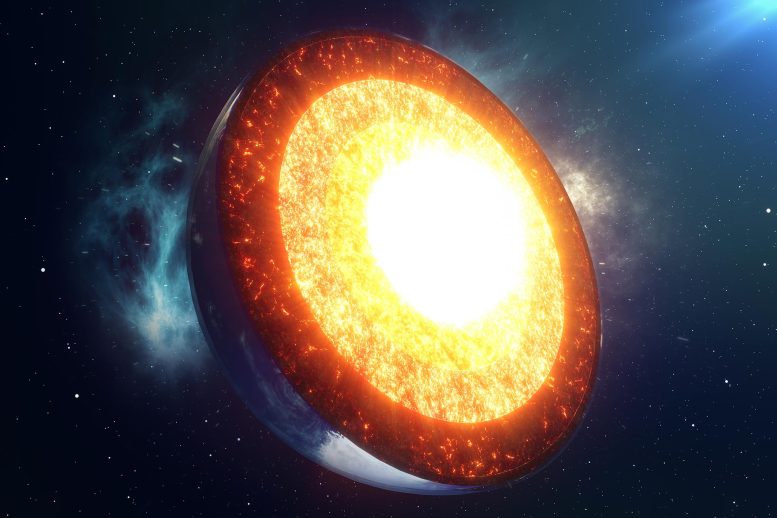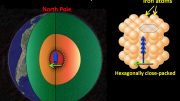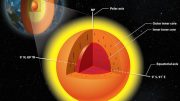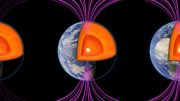
A new pressure scale was determined using advanced x-rays at RIKEN’s SPring-8 Center. The old scale was found to overestimate pressure by 20% at levels found in Earth’s core. This new scale’s implications are vast, with revelations that the inner core has about double the light material previously thought.
Researchers unveil a more accurate pressure scale using advanced x-rays, revealing Earth’s inner core has twice the light material previously estimated. Their methodology provides an easier path for future pressure measurements.
In research published on September 8 in the journal Science Advances, a team of scientists has determined a new pressure scale, which is critical for understanding the Earth’s composition.
Using x-rays from a uniquely powerful spectrometer at RIKEN’s SPring-8 Center they avoided some of the large approximations of previous work, discovering that the previous scale overestimated pressure by more than 20% at 230 gigapascals (2.3 million atmospheres) — a pressure reached in Earth’s core. This is similar to someone running a marathon that they thought was 26 miles (42 kilometers), but finding they had only really run 21 miles (34 kilometers). While 20% might seem like a modest correction, it has big implications.
Implications for Earth’s Composition
An accurate pressure scale is critical for understanding the composition of the Earth. In particular, the core composition is hotly debated as it is important both for understanding our planet at present, and for understanding the evolution of the solar system in the distant past.
While it is generally accepted that the core is mostly iron, evidence from tracking the propagation of seismic waves from earthquakes suggests the core also contains lighter material.
When the new scale was used to interpret the seismological model, the team found that the amount of light material in the inner core was about double what was previously expected, and indeed the total mass of light material in the entire core is probably five times, or more, that of the Earth’s crust – the layer that we live on.
Research Methodology
In the new work, the team, led by Alfred Q.R. Baron of the RIKEN SPring-8 Center, and Daijo Ikuta and Eiji Ohtani of Tohoku University, used Inelastic X-ray Scattering (IXS) to measure the sound velocity of a rhenium sample under pressure. A tiny rhenium sample (<0.000000001 grams = 1 nanogram) was put under extreme pressure by crushing it between two diamond crystals in a Diamond Anvil Cell (DAC).
The cell was placed in the large IXS spectrometer at BL43LXU (figure 2) and small (~1 ppm) shifts in the energy of the x-rays scattered from the rhenium were carefully measured, allowing the researchers to determine the sound velocity of the rhenium.
They determined both compressional/longitudinal and shear/transverse sound velocities, and the density of the rhenium. That allowed the researchers to determine the pressure that the rhenium was subjected to.
Rhenium Density as a Pressure Indicator
The new study provides a direct relationship between rhenium density and pressure. Baron says, “The density of rhenium at high pressure is straightforward and fast to measure, and there are many facilities worldwide where such measurements can be made. However, measuring the sound velocity is much more difficult, and, at these pressures, is probably only practically possible using RIKEN’s spectrometer at BL43LXU of SPring-8.”
The team has done the heavy lifting so that other scientists can now use a much easier-to-measure density to determine pressure.
As Ikuta, Ohtani, and Baron say: “When we used our new scale to interpret the behavior of metallic iron under high pressure and compared it with the seismic model of the Earth, we found that the light material hidden in the inner core is probably about double what was previously expected. Similar changes, perhaps even larger in magnitude, may be expected in considering the structure of other planets. Our work also suggests a reassessment of the pressure dependence of nearly all material properties that have been measured at pressures similar or larger than that of the Earth’s core.”
Reference: “Density deficit of Earth’s core revealed by a multimegabar primary pressure scale” by Daijo Ikuta, Eiji Ohtani, Hiroshi Fukui, Tatsuya Sakamaki, Rolf Heid, Daisuke Ishikawa and Alfred Q. R. Baron, 8 September 2023, Science Advances.
DOI: 10.1126/sciadv.adh8706









That would seem to make sense, because, although,I had heard it told, as a child that the core was an iron-nickel alloy, that explanation never sat well with me because it seemingly totally ignored both the abundance of carbon and it’s solubility in iron alloys, not to mention that at such high pressures carbon might fit in nicely in a sort of crystalline, albeit liquid, which might possibly explain why it is that the earth seems to have unlimited quantities of methane to give up, and the other being; why is the Earth almost always relatively negative while the the sky is positive? Despite all the mumbojumbo about neutrinos never interacting; maybe to a slight extent with the core they do, as they do with even water; I forget what the nuclear reaction would be other than it produced an election. Of course, it might just have been a childhood nightmare.